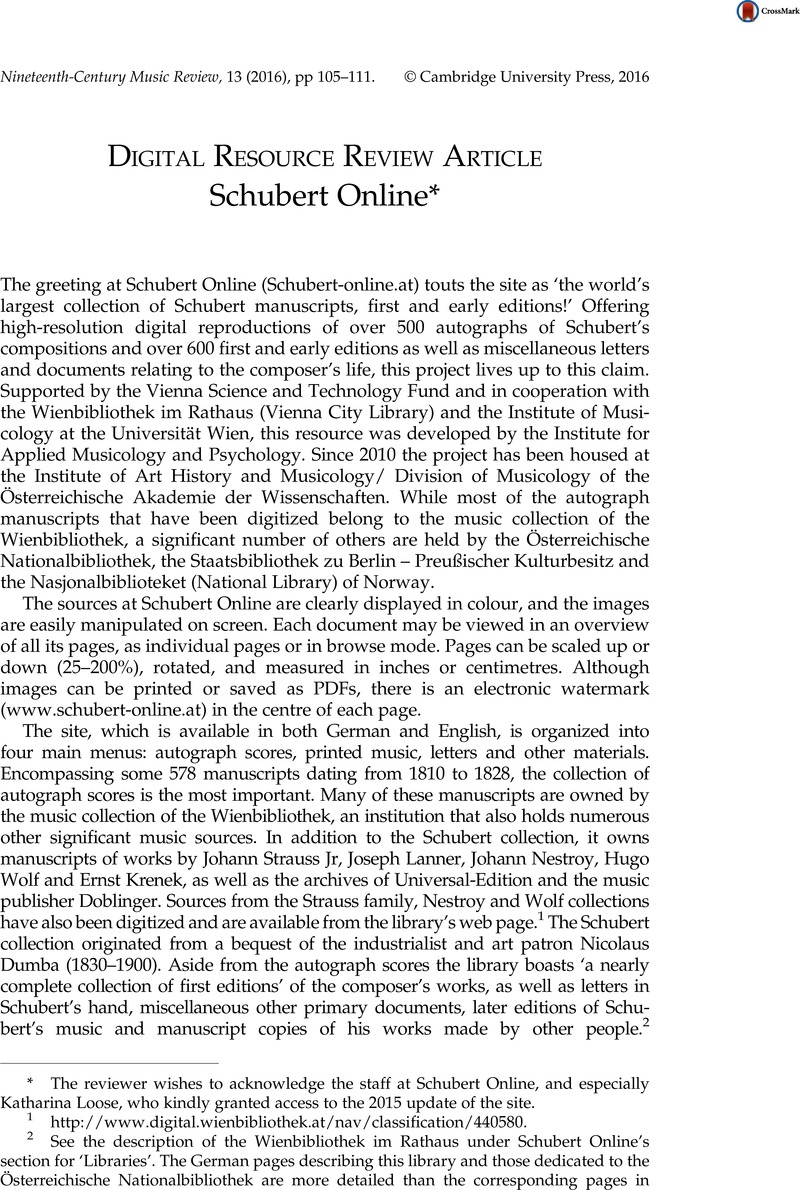No CrossRef data available.
Article contents
Schubert Online*
Published online by Cambridge University Press: 04 April 2016
Abstract

- Type
- Digital Resource Review
- Information
- Copyright
- © Cambridge University Press 2016
Footnotes
The reviewer wishes to acknowledge the staff at Schubert Online, and especially Katharina Loose, who kindly granted access to the 2015 update of the site.
References
2 See the description of the Wienbibliothek im Rathaus under Schubert Online’s section for ‘Libraries’. The German pages describing this library and those dedicated to the Österreichische Nationalbibliothek are more detailed than the corresponding pages in English, and they include bibliographies of German language publications related to the respective music collections.
3 Hilmar, Ernst, Verzeichnis der Schubert-Handschriften in der Musiksammlung der Wiener Stadt-und Landesbibliothek (Kassel: Barenreiter, 1978)Google Scholar. Facsimile editions include: Drei grosse Sonaten für das Pianoforte: D 958, D 959 und D 960 (frühe Fassungen): Faksimile nach den Autographen in der Wiener Stadt- und Landesbibliothek, ed. Ernst Hilmar (Tutzing: Schneider, 1987) and Der Graf von Gleichen Oper in zwei Akten (D 918): Erstveröffentlichung der Handschrift des Komponisten aus dem Besitz der Wiener Stadt- und Landesbibliothek, ed. Ernst Hilmar (Tutzing: Schneider, 1988). Although set up as a review of these facsimile editions, Richard Kramer’s article ‘Posthumous Schubert’ offers a glimpse of the types of specific information that can be obtained from a careful study of Schubert’s manuscripts. ‘Posthumous Schubert’, 19 th -Century Music 14/2 (1990): 197–216. This article concentrates exclusively on sources at the Wienbibliothek. More typically, studies of Schubert’s creative process draw on sources from this library along with those from other institutions, see for instance Kramer’s, Distant Cycles: Schubert and the Conceiving of Song (Chicago: University of Chicago Press, 1994)CrossRefGoogle Scholar or Denny, Thomas A., ‘The Years of Schubert’s A-Flat-Major Mass, First Version: Chronological and Biographical Issues, 1819–1822’, Acta Musicologica 63/1 (1991): 73–97 CrossRefGoogle Scholar. The url for the Neue Schubert-Ausgabe is http://schubert-ausgabe.de/en/.
4 For information regarding the sources for this symphony see Newbould, Brian, ‘Schubert’s Last Symphony’, The Musical Times 126 (1985): 272–273 CrossRefGoogle Scholar, 275.
5 The ‘Help’ section of Schubert Online includes a link to a general description of Deutsch’s catalogue available at Wikipedia. In contrast, the landing page for the Schubert site at imslp.org includes a link to a digital version of the Thematisches Verzeichnis seiner Werke in chronologischer Folge, 2nd edition (Kassel: Bärenreiter, 1978), which is located at archive.org: https://archive.org/details/FranzSchubert.ThematischesVerzeichnisSeinerWerkeInChronologischerFolge.
6 The home page of the music collection of the Österreichische Nationalbibliothek is www.onb.ac.at/sammlungen/musik.htm.
7 The url for the Beethoven-Haus site is http://www.beethoven-haus-bonn.de. For the manuscript of ‘Sehnsucht’ at the Library of Congress, see: http://lcweb2.loc.gov/diglib/ihas/loc.natlib.ihas.200153139/default.html.
8 Mario Aschauer edited this work for the Schubert complete edition, and his subsequent recording (with Harmony of Nations) includes a description of the manuscript sources. Adrast D 137: Einzelnummern und Entwürfe zu einer Oper, Franz Schubert: Neue Ausgabe sämtlicher Werke II/12, ed. Mario Aschauer (Kassel: Barenreiter, 2010). Adrast D 137: Einzelnummern und Entwürfe zu einer Oper, Klingende Forschung, Vol. 1 (Vienna: Verlag der Österreichischen Akademie der Wissenschaften, 2012).
9 Morten Solvik references these manuscripts of ‘Schwangesang’ and ‘Luisens Antwort’ in ‘Schubert’s Kosegarten Settings of 1815: A Forgotten Liederspiel’, in Franz Schubert and His World, ed. Christopher H. Gibbs and Morten Solvik (Princeton: Princeton University Press, 2014), 115–56.
10 The copy at the digital collection of the Berlin Staatsbibliothek is displayed at http://digital.staatsbibliothek-berlin.de/werkansicht/?PPN=PPN655180834&LOGID=LOG_0001.
This volume of Schubert lieder was reproduced in a facsimile edition in 1943 and then again in Schubert, Franz, Sechzehn Goethe-Lieder, ed. Peter Hauschild (Leipzig: Peters, 1978)Google Scholar. Walther Dürr describes this collection of songs in ‘Aus Schuberts erstem Publikationsplan: Zwei Hefte mit Liedern von Goethe’, in Schubert-Studien: Festgabe der Österreichischen Akademie der Wissenschaften zum Schubert-Jahr 1978, ed. Franz Grasberger and Othmar Wessely (Vienna: Österreichischen Akademie der Wissenschaften, 1978): 43–56.
11 See for instance Robert Winter’s critique of Hilmar’s, Verzeichnis der Schubert-Handschriften in ‘Cataloguing Schubert’, 19 th -Century Music 3/2 (1979): 157–162 Google Scholar. Points of conflict with Hilmar also recur throughout Winter’s ‘Paper Studies and the Future of Schubert Research’, in Schubert Studies: Problems of Style and Chronology, ed. Eva Badura-Skoda and Peter Branscombe (Cambridge: Cambridge University Press, 1982), 209–75.
12 Winter discussed some of the important issues concerning the reproduction of the watermarks in ‘Cataloguing Schubert’, 158–9. He supplied his own reproductions for some of the watermarks on paper Schubert used in the last six years of his life in ‘Paper Studies’, 269–75.
13 Research for this review began using the older version of the website. In August 2015 the reviewer was given full access to test pages of the revamped site. During this process, the editors of Nineteenth-Century Music Review alerted the staff at Schubert Online to a small number of problems, all of which were addressed during the redesign.
14 For the Juilliard collection, see http://juilliardmanuscriptcollection.org/composers/schubert-franz/. For the Morgan Library, see: http://www.themorgan.org/collection/music-manuscripts-and-printed-music/115655.





